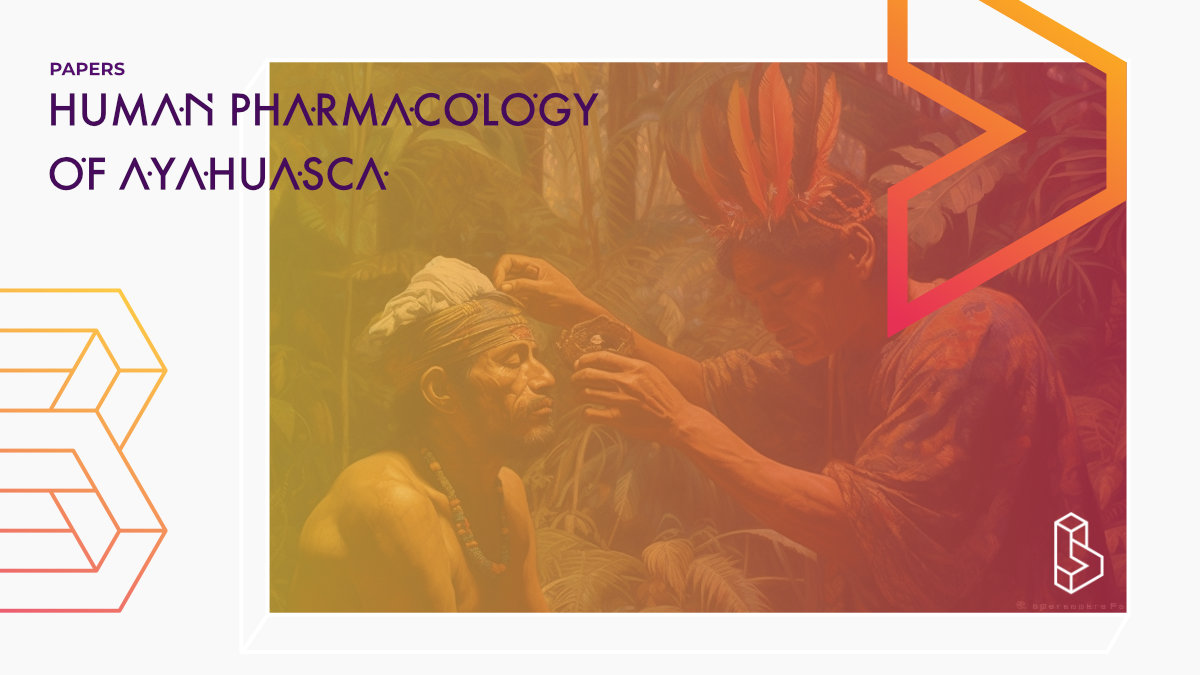This re-analysis of a double-blind, placebo-controlled clinical study (n=18) investigated the subjective and cardiovascular effects and alkaloid pharmacokinetic properties of orally ingested ayahuasca (42-60mg DMT/70kg) in healthy volunteers. The time course of DMT plasma concentrations closely paralleled subjective effects. The pharmacokinetic results indicated a predominantly harmine-DMT interaction in the gastrointestinal tract and possibly in the liver.
Abstract of Human pharmacology of ayahuasca
“Introduction: The effects of the South American psychotropic beverage ayahuasca on subjective and cardiovascular variables and urine monoamine metabolite excretion were evaluated, together with the drug’s pharmacokinetic profile, in a double-blind placebo-controlled clinical trial. This pharmacologically complex tea, commonly obtained from Banisteriopsis caapi and Psychotria viridis, combines N,N-dimethyltryptamine (DMT), an orally labile psychedelic agent showing 5-hydroxytryptamine2A agonist activity, with monoamine oxidase (MAO)-inhibiting β-carboline alkaloids (harmine, harmaline, and tetrahydroharmine).
Methods: Eighteen volunteers with prior experience in the use of psychedelics received single oral doses of encapsulated freeze-dried ayahuasca (0.6 and 0.85 mg of DMT/kg of body weight) and placebo.
Results: Ayahuasca produced significant subjective effects, peaking between 1.5 and 2 h, involving perceptual modifications and increases in ratings of positive mood and activation. Diastolic blood pressure showed a significant increase at the high dose (9 mm Hg at 75 min), whereas systolic blood pressure and heart rate were moderately and nonsignificantly increased. Cmax values for DMT after the low and high ayahuasca doses were 12.14 ng/ml and 17.44 ng/ml, respectively. Tmax (median) was observed at 1.5 h after both doses. The Tmax for DMT coincided with the peak of subjective effects. Drug administration increased urinary normetanephrine excretion, but, contrary to the typical MAO-inhibitor effect profile, deaminated monoamine metabolite levels were not decreased.
Discussion: This and the negligible harmine plasma levels found suggest a predominantly peripheral (gastrointestinal and liver) site of action for harmine. MAO inhibition at this level would suffice to prevent first-pass metabolism of DMT and allow its access to systemic circulation and the central nervous system.”
Authors: Jordi Riba, Marta Valle, Gloria Urbano, Mercedes Yritia, Adelaida Morte & Manel J. Barbanoj
Summary of Human pharmacology of ayahuasca
Ayahuasca is a psychotropic plant tea shamans use throughout the Amazon Basin in traditional medicine, rites of passage, and magico-religious practices. It has become more widespread and frequent consumption by members of several modern Brazilian-based syncretic religious groups.
DMT is structurally related to the neurotransmitter serotonin and acts as an agonist at 5-hydroxytryptamine 2A receptors in the central nervous system. It also exerts marked autonomic effects elevating blood pressure, heart rate, and rectal temperature, and causes mydriasis. Agurell and coworkers postulated that the interaction between -carbolines and DMT in ayahuasca “might result in specific pharmacological effects”. It is now widely accepted that harmine prevents the enzymatic degradation of DMT, allowing its absorption.
In a double-blind, placebo-controlled crossover clinical trial with ayahuasca, a group of healthy volunteers assessed the MAO-inhibitory effects of ayahuasca. Additionally, the time course of MAO inhibition was studied in urine by measuring monoamine metabolites.
Find this paper
https://doi.org/10.1124/jpet.103.049882
Open Access | Google Scholar | Backup | 🕊
Cite this paper (APA)
Riba, J., Valle, M., Urbano, G., Yritia, M., Morte, A., & Barbanoj, M. J. (2003). Human pharmacology of ayahuasca: subjective and cardiovascular effects, monoamine metabolite excretion, and pharmacokinetics. Journal of Pharmacology and Experimental Therapeutics, 306(1), 73-83.
Study details
Compounds studied
Ayahuasca
Topics studied
Healthy Subjects
Study characteristics
Original Re-analysis
Placebo-Controlled
Double-Blind
Within-Subject
Randomized
Participants
18
Humans
Authors
Authors associated with this publication with profiles on Blossom
Jordi RibaJordi Riba (1968 - 2020†) was a pioneering ayahuasca researcher who dedicated over two decades of work to the field. His work focussed on the pharmacokinetics and pharmacodynamics of ayahuasca, including alkaloid disposition, and electroencephalography, and neuroimaging measures of acute ayahuasca effects. He also conducted several studies on centrally-acting drugs on the acute and long-term effects of psychedelics, psychostimulants, cannabinoids, sedatives, and kappa-opioid receptor agonists. His later work moved towards investigating the neural and psychological mechanisms that could underlie the beneficial effects of ayahuasca in the treatment of various psychiatric conditions.
Institutes
Institutes associated with this publication
Hospital de Sant PauThis research institute is linked to a study but doesn't have a full profile yet.
Compound Details
The psychedelics given at which dose and how many times
Ayahuasca 42 - 60mg | 3x
Linked Research Papers
Notable research papers that build on or are influenced by this paper
Topographic pharmaco-EEG mapping of the effects of the South American psychoactive beverage ayahuasca in healthy volunteersThis double-blind, crossover, placebo-controlled clinical study (n=18) investigated the effects of ayahuasca (42-60mg DMT/70kg) on temporal brain activity in healthy volunteers and found an absolute power decrease in all frequency bands measured with EEG, which paralleled the time course of its subjective effects.

